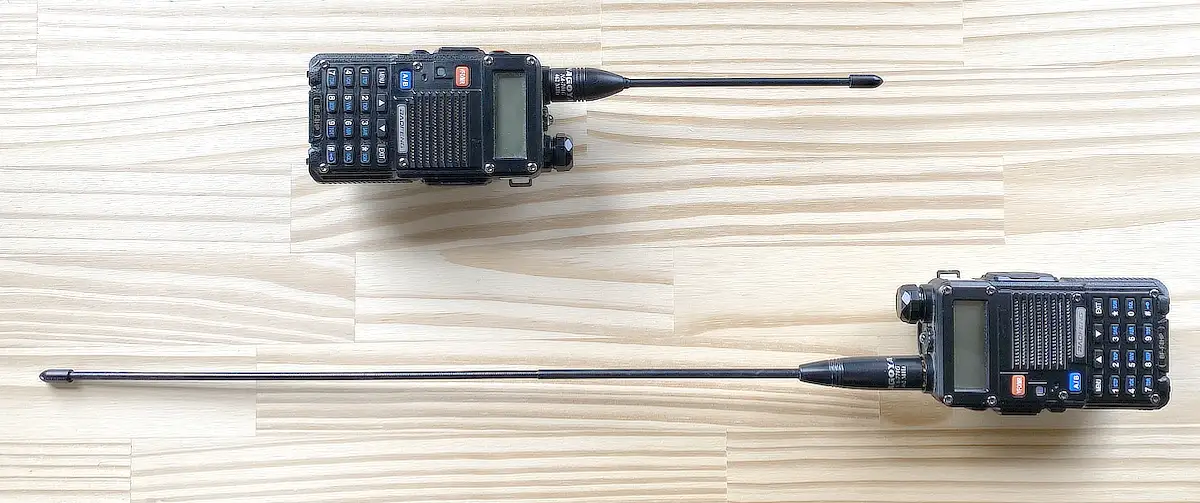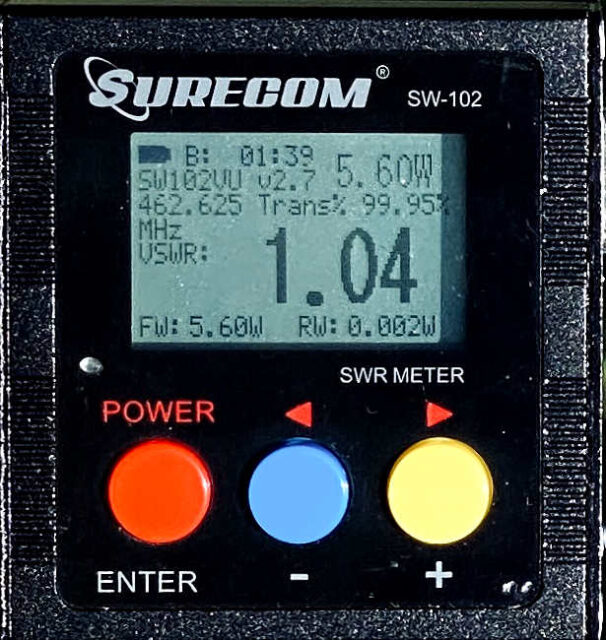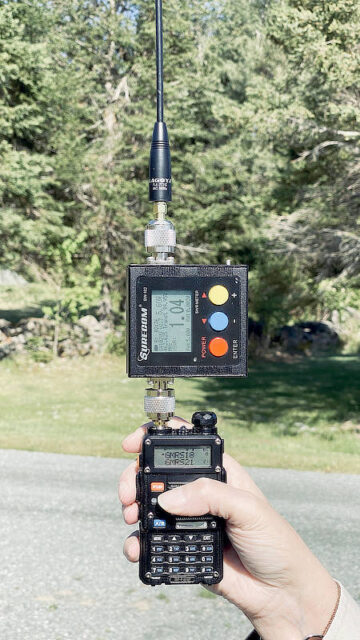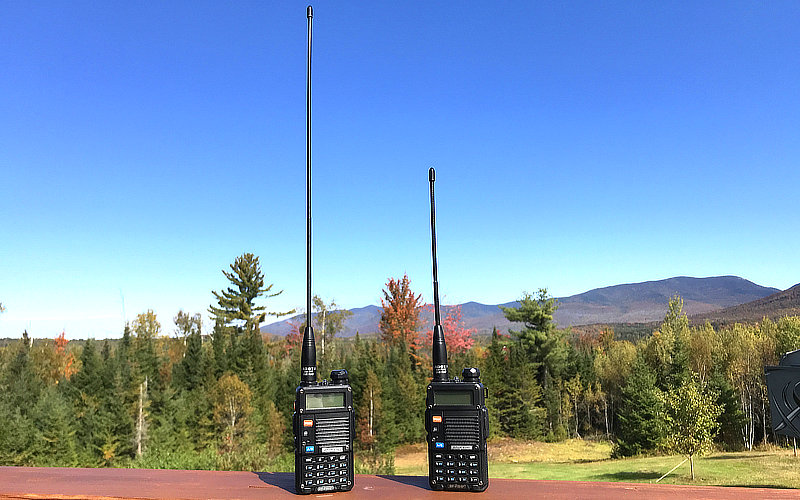Best Antenna For Baofeng – Ham, GMRS/FRS, MURS, & Business Bands

Here is my researched opinion, coupled with real-world experience and testing of the best antenna upgrades for a Baofeng UV-5R, BF-F8HP, or other Baofeng VHF/UHF handheld (HT) radios with a removable antenna.
I recently purchased a VSWR / power meter that enables direct connection to the Baofeng to test antennas for various frequency bands.
The best choice antenna depends on the frequency band or bands you intend to operate on. The recommendations listed below are based not only on their specifications but also on my own VSWR testing.
While many antennas may receive well enough outside their Tx optimized frequencies, the antenna you choose must be tuned to TRANSMIT within the band(s) you’ll be operating on for optimal performance.
Jump down the page to…
I am focusing on the popular Baofeng UV-5R 2-way radios (or variants thereof, like my favorite version, the BF-F8HP). The stock Baofeng antenna, while functional, may not meet your needs.
Suppose you’re serious about optimizing the maximum transmit distance. In that case, the specific Baofeng antenna upgrade choices listed below are practical solutions that will empower you to get the most out of your radio!
First. Why the Baofeng brand? Sure, there are better radios. But,
- Price vs Features. Baofeng found an inexpensive sweet spot.
- Wide frequency range for Transmit (Tx) and Receive (Rx).
- Easy to program with free ‘CHIRP’ software.
- There are no technical restrictions to transmit on any frequency of the radio’s capabilities. (Though there are Legal restrictions)
Best Antenna Upgrades For Baofeng Handheld Radios
That said, there are lots of these Baofeng radios out there. I, too, have several sets (among other brands). So, I am sharing my recommendation for a Baofeng antenna upgrade that will perform better on your radio. I have them for all my Baofeng radios.
Okay, enough already! What about the best antenna for the Baofeng UV-5R (or BF-F8HP)?
I don’t want to get all technical here, but I do have to dip into it to some extent.
Depends On Which Frequency Bands You Intend To Use For Communications:
This is a crucial consideration! It matters. Your Baofeng antenna upgrade choice depends on the frequencies where you intend to operate. Antennas are designed for specific frequencies or range of frequencies. Therefore, operating (transmitting) at a frequency outside the antenna’s design parameters will not only produce poor results but could also potentially damage the radio!
Baofeng Antenna for Ham Radio Bands 144/430
The Ham Radio bands on the Baofeng radio require a license if you are going to transmit (receiving is, of course, free). They are as follows:
VHF (Ham band) 144-148 MHz (2 Meter band)
UHF (Ham band) 420-450 MHz (70-centimeter)
I may earn commission (no extra cost) if purchased.
Thank you
Best Baofeng antenna upgrade for Ham Radio bands 144/430:
(BTECH on Amazon)
It’s a 15.6-inch dual-band whip designed for Ham radio.
The NAGOYA NA-771 antenna is Tx optimized for 140-150 MHz and 420-450 MHz.
The exact optimization is 144 MHz and 430 MHz and has a gain of 2.5 dBi.
My SWR tests indicated the NA-771 performed better than the Diamond SRJ77CA I also had.
If you’re looking for a very flexible whip, this antenna has another design. Nagoya says, “Most notably, the alloy whip is vastly improved for flexibility and durability.”
NA-24J
Best Baofeng Antenna for GMRS/FRS
The NAGOYA NA-701G antenna works best for the GMRS/FRS bands. Tx (transmit) is optimized for 462-468 MHz UHF frequencies.
This antenna will function best when operating on GMRS / FRS channels (frequencies / ‘band’). Again, the FCC rules for transmitting on GMRS are beyond the scope of this article.
Best antenna upgrade for Baofeng GMRS/FRS:
(BTECH on Amazon)
The best SWR obtained on the NA-771G

I used the Surecom SW-102 for measurements. Although I have a nice Daiwa SWR meter, this one enables direct connection for handheld radios. I’m not claiming it’s perfect. Many variables exist while measuring HT antenna SWR and other better and more expensive testing methods. However, it’s reasonable to use it to compare one antenna to another.
The NAGOYA NA-771G and the NA-701G antenna are Tx (transmit) optimized for the GMRS / FRS channel frequencies.
The exact optimization (at least where they specify ‘gain’) is 462 MHz.
The NA-771G has an incredible gain of 4.75 dBi. However, it is 15.3 inches long and may not be best suited for pocket carry or belt-clip wear. But it sure does perform very well.
Depending on how the radio was held, SWR measurements ranged between 1.04 and 1.25: 1, which is excellent!

Its little brother, the NA-701G, with its 5.5-inch whip and 2.15 dBi gain, didn’t perform quite as well as the tall whip (to be expected) but was still very good.
I keep both model antennas because they each have advantages and perform well!
Difference Between NA-771G and NA-701G

The NA-771G has a significant gain advantage. My measured SWR is excellent for this antenna, with essentially 100% of radio power being used (negligent reflected power). But as you can see in my photo above, that antenna will get in the way of things under some uses and circumstances. Although there are other uses and circumstances where this won’t be a particular problem, you WILL get more range from this one.
The NA-701G is the best choice antenna for everyday use with GMRS. The antenna will not get in the way, and it still performs very well for any typical expected communication distances that one might expect from these radios.
With that said, the most critical factor for VHF / UHF transmit range (distance) is the height above ground level; the higher up, the better.
GMRS (General Mobile Radio Service)
GMRS is a set of frequencies near 462 MHz and 467 MHz (some shared with FRS), popular and often shared on FRS/GMRS “bubble pack” radios. Transmitting on GMRS-specific frequencies technically requires a “no-test” license (suitable for the whole family and 10 years. $35 as of this update). However apparently, the FCC has not enforced this requirement that I know of.
FRS (Family Radio Service)
A set of frequencies near 462 MHz and 467 MHz. You do not need a license to operate on FRS ‘channels.’ It’s today’s low-power “walkie-talkie” band.
Best Baofeng Antenna for PLMRS (Commercial/Business), MURS, Maritime (Marine Radio)
MURS (Multi-Use Radio Service)
A set of five frequencies near 151 MHz and 154 MHz. A wide variety of radio products use MURS frequencies beyond just voice communications. Transmitting on MURS-designated frequencies does not require a license.
Maritime Mobile
The Marine radio band falls on frequencies within the spectrum between 156 and 162 MHz. Mariners and boaters use the Marine band to communicate. In the case of recreational boaters, for the most part, no license is required.
PLMRS (Private Land Mobile Radio Services)
The ‘commercial business’ band is within the spectrum between 150 and 174 MHz. It’s also generally known as the business radio band. Transmitting on these frequencies requires a license.
Best upgrade antenna for Baofeng for MURS, Business, and Maritime bands:
(BTECH on Amazon)
The NAGOYA NA-701C antenna works best for the Business, MURS, and Maritime bands. Tx (transmit) is optimized for 150-165 MHz VHF frequencies.
The exact optimization is 155 MHz. It has a gain of 2.5 dBi and a whip length of 8 inches.
Note: Their specifications for this antenna indicate that it will also perform in the UHF band (450 – 470 MHz), which would, in theory, cover GMRS / FRS. But not so fast. Hold your horses.
My SWR testing indicates this is not the best case, with poor SWR. This may be why they developed the 771G and 701G, as described above. For this reason, I no longer recommend the 701C antenna for GMRS / FRS.
- The 701C tuned the best (commercial bands) between 153-155 MHz (essentially a perfect SWR)
- MURS channels SWR ranged from 1.8 to 2.4: 1, which isn’t bad
- Maritime (marine band) SWR ranged from 1 to 1.7: 1

Why Are Baofeng Portable 2-way Radios Popular?
Why do preparedness-minded people purchase 2-way handheld VHF/UHF radios like the Baofeng UV-5R or BF-F8HP?
Excellent features and technical capabilities versus price.
These radios fulfill the need for local two-way communications and relaying information. This will become especially important following a disaster or worse. Today’s conventional methods of communication may fail. As a result, cell phones, the internet, and other digital communications may become inoperable without grid power.
Portable 2-way HT handheld radios will enable a local community to communicate with each other (for example). This will also provide serious advantages for regional security. Similarly, 2-way radio communications will enhance one’s personal / home security.
I recommend the following model choice (if you’re going with Baofeng). It’s a step up from the original UV-5R. And newly purchased radios can (apparently) still transmit on FRS/GMRS/MURS/Marine bands (see update below).
BF-F8HP
(amzn)

How To Unlock The New Baofeng UV-5R
Update: Apparently new Baofengs are now limited to only transmitting on ham radio frequencies. 144-148 MHz, 222-225 MHz, 420-450 MHz. But can receive on other bands just like they used to.
Due to FCC action, new Baofeng radios may be locked outside the ham bands. Please be aware of this when you purchase new devices.
That means they cannot be used to transmit on MURS, GMRS, FRS, Marine VHF, or Part 90 business frequencies. This puts their radio into FCC compliance.
Edit: This seems to apply only to USA-sold/distributed models.
Update: Apparently there is a way to unlock/unblock/jailbreak the transmit frequencies on the newer Baofeng UV-5R radios so they function just like they used to. You might simply search online for the “how-to unlock Baofeng UV-5R”.
(FCC rules are beyond the scope of this article.)
You may be interested in some of the following articles:
This Baofeng Extended Battery For Mission Critical Operations
Program a Baofeng Radio with CHIRP – Quick Start
VHF versus UHF for Handheld Radio Communications
2-way Radios for Communications
